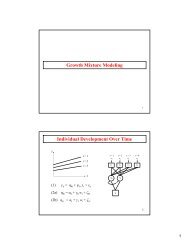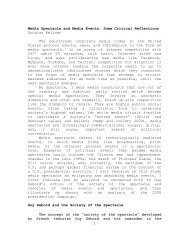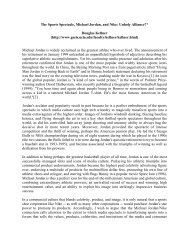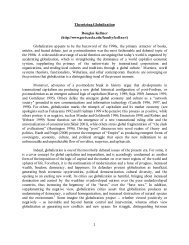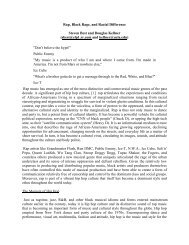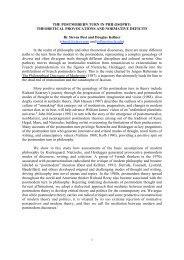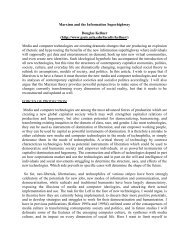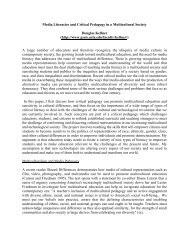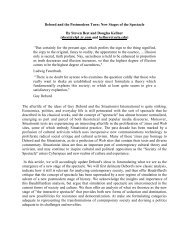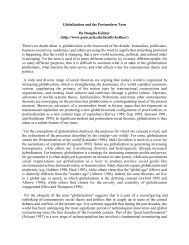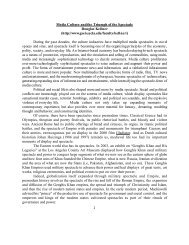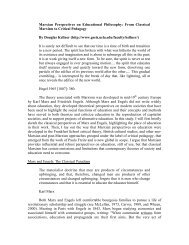Rachel Leff and Rachel Longaker IS281 Professor Maack ... - Ucla
Rachel Leff and Rachel Longaker IS281 Professor Maack ... - Ucla
Rachel Leff and Rachel Longaker IS281 Professor Maack ... - Ucla
You also want an ePaper? Increase the reach of your titles
YUMPU automatically turns print PDFs into web optimized ePapers that Google loves.
<strong>Rachel</strong> <strong>Leff</strong> <strong>and</strong> <strong>Rachel</strong> <strong>Longaker</strong><br />
<strong>IS281</strong><br />
<strong>Professor</strong> <strong>Maack</strong><br />
March 22, 2007<br />
William Morris as Printer: A Historiographical Approach<br />
Because of the extraordinary nature of his achievements as an artist <strong>and</strong><br />
craftsman, writer <strong>and</strong> political activist, William Morris was a compelling biographical<br />
subject for writers even before his death in 1896. Fascination with him continues to the<br />
present day. We will compare different biographies of Morris <strong>and</strong> will focus on the<br />
significance of the founding of the Kelmscott Press <strong>and</strong> his work as printer. In writing a<br />
historiographical essay that examines the way different biographers view this aspect of<br />
his work <strong>and</strong> life, one can perhaps learn about the time in which he lived, the forces that<br />
were working on Morris <strong>and</strong> how Morris was or was not a product of his time.<br />
In addition to looking at how historians have viewed Morris as a printer, we will<br />
examine the influence Morris’s work exerted on printing. Of particular interest are the<br />
ways that historians of art <strong>and</strong> print have contextualized his influence. Some historians<br />
show his influence as revolutionary while others suggest that his influence has been<br />
overstated.<br />
The chronological limits of the paper are 1888 to 1898, which spans from<br />
Morris’s attendance at a lecture on printing by Emery Walker to the closing of Kelmscott
Press, two years after Morris’s death. This period will be examined in terms of how<br />
various biographers have understood <strong>and</strong> contextualized his achievements at the Press as<br />
well as how historians have understood <strong>and</strong> contextualized his influence on print.<br />
In looking at Morris as a biographical subject, we will focus on how biographers<br />
have depicted the years from 1888 to 1896 years as a critical time in his life. He was at<br />
the height of his fame <strong>and</strong> had enormous influence over the artistic <strong>and</strong> cultural milieu in<br />
which he lived. Was the impetus to found the Kelmscott Press a new direction for him, or<br />
was it part of a continuum? Different biographers bring their viewpoints to bear in how<br />
they see Morris’s development as an important figure in print culture. In looking at his<br />
influence on the world of book design, the time frame will necessarily be after 1896, but<br />
will focus as much as possible only on his book work, not his larger body of design.<br />
Biographical Historiography<br />
printer?<br />
Research Questions<br />
1. How have different biographers viewed what influenced Morris’s work as a<br />
2. How have different biographers depicted the story of the Kelmscott Press <strong>and</strong><br />
Morris’s motivations for beginning the enterprise?<br />
3. What are some of the social <strong>and</strong> historical forces that played a role in Morris’s<br />
enterprise with Kelmscott?<br />
Design Influence<br />
<strong>Leff</strong> <strong>and</strong> <strong>Longaker</strong>, Page 2
1. William Morris has exerted an enormous influence in the world of design.<br />
What kind of influence did his work at Kelmscott Press have on the world of book design<br />
<strong>and</strong> fine printing?<br />
2. How have historians viewed his influence? Do they believe it has been stronger<br />
in some time periods than others?<br />
3. Have historians seen that certain schools have been interested in continuing his<br />
advancements? Have they seen others that have been opposed to his achievements?<br />
Statement on Sources<br />
Sources<br />
The biographies written about Morris in the beginning of the twentieth century<br />
differ in their outlooks from those written almost a hundred years later. Notions of what<br />
is acceptable in a biography changed <strong>and</strong> this shifted the way Morris was treated. His<br />
official biographer, writing in 1899, decided that Morris’s epilepsy was not a subject that<br />
should be public knowledge. A new openness became inevitable due to changing<br />
expectations of how a biography is meant to shed light on its subject. Where the personal<br />
suffering Morris experienced in his marriage is only referred to obliquely by his earlier<br />
biographers, it is completely out in the open by the time the end of the century comes<br />
around. As more sources such as previously undisclosed private letters became available,<br />
these materials helped biographers answer questions about Morris’s marriage <strong>and</strong> gain<br />
insight into his thoughts <strong>and</strong> concerns. Distance also helps gain a more balanced<br />
perspective. Morris’s commitment to socialism is seen more clearly as biographers move<br />
further away from the actual political upheaval of Britain in the 1880’s.<br />
<strong>Leff</strong> <strong>and</strong> <strong>Longaker</strong>, Page 3
A noticeable gap in the literature seems to be the treatment of Morris’s wife, Jane<br />
or Janey. In most biographies she is portrayed in an unsympathetic light. She is seen as a<br />
beautiful woman who was lucky to have a man such as Morris fall in love with her, while<br />
remaining distant <strong>and</strong> indifferent to him. Her father was a stableh<strong>and</strong>, <strong>and</strong> instead of<br />
being grateful to Morris for elevating her to an affluent, privileged life, her behavior<br />
towards him seems aloof, capricious, even cruel. Some biographers have attempted to<br />
look more closely at the dynamic between Morris <strong>and</strong> Janey <strong>and</strong> seem sensitive to the<br />
notion that her role as Morris’s wife might have been a burden, an advantage that came<br />
with psychological costs. A biography devoted to Janey’s life would be interesting to<br />
read <strong>and</strong> it would shed more light on Morris as well.<br />
While Morris has inspired many biographies that aim to capture the life <strong>and</strong> work<br />
of this larger-than-life figure, fewer historians have looked specifically at his influence on<br />
book design. Many histories of print mention Morris <strong>and</strong> his work at Kelmscott Press, but<br />
they are limited assessments. And where a larger investigation has been made into his<br />
work as a designer, the authors tend to offer a positive assessment. In other words, there<br />
are few works that take a truly critical approach to Morris’s effect on printing. Given the<br />
highly ornate style he employed <strong>and</strong> the austere aesthetic that modernists adopted, one<br />
might think that a work from a modernist framework might offer a more scathing<br />
assessment of Kelmscott <strong>and</strong> its influence. No such works were located. Perhaps a reason<br />
for this is that those historians drawn to Morris tend to appreciate his work. Another<br />
reason may be that the works of Kelmscott were not seen as offering enough of a<br />
dominant influence to be specifically rebelled against by an opposing aesthetic.<br />
Historical Biography<br />
<strong>Leff</strong> <strong>and</strong> <strong>Longaker</strong>, Page 4
The first work we will analyze is J.W. Mackail’s (1899) The Life of William Morris<br />
written a few years after Morris’s death. Commissioned by Morris’s family, Mackail’s depiction<br />
is informed by the spirit of Romanticism that influenced so much of Victorian life writing <strong>and</strong><br />
also typifies what the Encyclopedia of Life Writing describes as an Exemplary Life biography.<br />
Morris is seen as an extraordinary man whose life provides a model of focused activity <strong>and</strong><br />
impressive accomplishment. Esther Meynell’s (1947) Portrait of William Morris was written<br />
four decades later, after Lytton Strachey’s Emiment Victorians heralded the arrival of a new<br />
approach in biographical writing. Meynell’s portrait is informed by psychoanalysis in that it sees<br />
Morris as a contradictory figure, artistically blessed, yet privately dominated by conflicts that<br />
belied his public accomplishments. We will also look at three historical biographies, one written<br />
by the Marxist historian E.P. Thompson (1955) <strong>and</strong> two works by Charles Harvey <strong>and</strong> Jon Press<br />
(1991, 1996). Here we will consider how Morris is framed by different historical perspectives: a<br />
British ‘New Left’ Marxist in the 1950’s <strong>and</strong> British social historians in the 1990’s. Lastly, we<br />
will look at two literary biographies of Morris, Fiona MacCarthy’s (1994) scholarly William<br />
Morris: A Life for Our Time <strong>and</strong> a recent article by Adela Spindler Roatcap (2003) that focuses<br />
on the Kelmscott Chaucer.<br />
Design Influence<br />
Sources from across a wide period will be consulted to determine how Morris's<br />
impact on book design over the last century has been assessed by historians. Sparling<br />
(1924) writes an overly enthusiastic <strong>and</strong> ultimately out-dated assessment of Morris’s<br />
work as a printer. Steinberg (1995), originally written in 1955, places Morris in the<br />
context of the history of print <strong>and</strong> offers a much more critical assessment of his<br />
endeavors. Briggs (1957) offers a more tempered if ultimately laudatory assessment.<br />
<strong>Leff</strong> <strong>and</strong> <strong>Longaker</strong>, Page 5
McLean (1959) writes from the perspective of book design <strong>and</strong> places Morris as the main<br />
progenitor of a resurgence of design principles in an era of degradation whose influence<br />
should not be underestimated. Thompson (1977) takes a critical art historical approach by<br />
taking a well-documented closer look at Morris <strong>and</strong> the Arts <strong>and</strong> Crafts book, which, she<br />
feels, has not been clearly understood or appreciated as a distinct art form. Peterson<br />
(1991) sets out to offer a critical study of Kelmscott, looking closely at the legacy of the<br />
Press. And Eckert, writing about Morris’s influence on bookmaking in Germany, offers a<br />
social <strong>and</strong> political perspective about why Morris was influential at specific times in<br />
Germany in the last century.<br />
Historical Background<br />
Fiona MacCarthy’s (2004) entry in the Oxford Dictionary of National Biography<br />
designates Morris as a designer, author, <strong>and</strong> visionary socialist. As a designer, Morris is most<br />
famous for being the father of the Arts <strong>and</strong> Crafts Movement. Since his youth, he had been<br />
drawn to medieval culture <strong>and</strong> an idealization of Engl<strong>and</strong>’s past. Reacting against the<br />
dehumanizing aspects of industrialization in Victorian Britain, the movement was meant to<br />
inspire a revolution in aesthetics <strong>and</strong> design, emphasizing beauty <strong>and</strong> the art of h<strong>and</strong>made crafts.<br />
Some biographers see the enormous success of Arts <strong>and</strong> Crafts as an example of Morris as a<br />
practical man of action. The son of a successful financier, he was able to make his artistic vision<br />
translate into successful design <strong>and</strong> later a printing business.<br />
Morris’s poetry <strong>and</strong> the books he printed at the Kelmscott Press were inspired by<br />
medieval legends <strong>and</strong> romances. After leaving Oxford, Morris circulated among the Pre-<br />
Raphaelites (the Italian Rennaissance painter Raphael was their ideal), a group of artists who<br />
<strong>Leff</strong> <strong>and</strong> <strong>Longaker</strong>, Page 6
sought to express a highly romantic style of painting <strong>and</strong> writing. They were also drawn to<br />
themes associated with medieval art <strong>and</strong> Arthurian legends. A few years older than Morris, the<br />
Pre-Raphaelite poet <strong>and</strong> painter Dante Rossetti was significant in Morris’s personal <strong>and</strong><br />
professional life, urging Morris to become a painter <strong>and</strong> writer.<br />
A few biographers believe that Morris’s artistic endeavors <strong>and</strong> his work in design were a<br />
natural springboard for his commitment to socialist ideals. Inspired by Marx’s writings <strong>and</strong> the<br />
revolutionary climate in Britain, Morris became a socialist in the 1880’s. He was aware of the<br />
irony that he was the head of a profit-making design company, Morris & Co., <strong>and</strong> that most of<br />
what he created was only enjoyed by the middle <strong>and</strong> upper classes. Towards the end of his life,<br />
he was disheartened by the idea that the social justice he envisioned was not going to be realized<br />
during his lifetime.<br />
William Morris began printing in earnest after attending a lecture delivered by<br />
Emery Walker in 1888. Morris had already shown an interest in medieval manuscript<br />
culture, both in terms of the content of early English works <strong>and</strong> in terms of the design<br />
elements of illumination. The quality of printing at this time was very low.<br />
Industrialization had touched all aspects of printing, from the mechanization of presses to<br />
lower quality wood-based paper to lower quality inks. As Morris had rebelled against<br />
industrialized production in so many other areas, he also rebelled in the arena of print.<br />
The rebellion took the form of Kelmscott Press, which he founded in 1891. The Press<br />
printed 53 books.<br />
Morris designed, had punched by h<strong>and</strong>, <strong>and</strong> utilized three new type faces: Golden,<br />
Troy, <strong>and</strong> Chaucer. He employed h<strong>and</strong> presses <strong>and</strong> h<strong>and</strong> carved wood plates for<br />
illustrations. For the works made at Kelmscott, he chose fine quality h<strong>and</strong>made paper <strong>and</strong><br />
<strong>Leff</strong> <strong>and</strong> <strong>Longaker</strong>, Page 7
vellum. Further, he looked to the early modern period <strong>and</strong> even the Middle Ages for<br />
design inspiration for layout, margins, illumination, rubication, <strong>and</strong> type face.<br />
Historical Biography<br />
Presentation of Contextual Background<br />
William Morris’s artistic gifts were not confined to one area of expression. It is fitting<br />
that biographical writings about him exist in many genres. There are portraits of him as a poet, a<br />
socialist, a “Victorian Rebel”, a “Pagan Prophet”, a “Medievalist <strong>and</strong> Revolutionary.” In this<br />
paper we will look at six biographical works about Morris that typify four genres of biography:<br />
Exemplary Life, “New Biography”, Historical, <strong>and</strong> Literary. In analyzing these depictions of the<br />
same subject’s life using different genres, we will also look at how the notion of biographical<br />
writing has developed <strong>and</strong> changed over time.<br />
When measured next to history, biography has often been considered the lesser craft. In<br />
Writing Lives: Principia Biographica, Leon Edel (1989) states that:<br />
The writing of lives is a department of history <strong>and</strong> is closely related to the<br />
discoveries of history. It can claim the same skills. No lives are led outside<br />
history or society; they take place in human time. No biography is complete<br />
unless it reveals the individual within history, within an ethos <strong>and</strong> a social<br />
complex (4).<br />
A critical overview of biographical writing is outlined in the Encyclopedia of Life Writing:<br />
Autobiographical <strong>and</strong> Biographical Forms (2001). Early nineteenth century Romantic writers,<br />
with their notion of the primacy of the individual’s subjective experience, were influential in<br />
transforming many forms of writing, especially those that focused on individual lives. In late<br />
eighteenth century Engl<strong>and</strong>, many factors contributed to the popularity of biographical writing:<br />
<strong>Leff</strong> <strong>and</strong> <strong>Longaker</strong>, Page 8
With empiricism, Protestantism, <strong>and</strong> capitalism fueling a new interest in the<br />
individual’s effort to wrest meaning <strong>and</strong> success from his or her encounters with<br />
the external world, biography flourished... (110).<br />
An influential work written in 1841 was Thomas Carlyle’s On Heroes, Hero-Worship,<br />
<strong>and</strong> the Heroic in History which advocated for histories that recounted the feats of “great men.”<br />
Carlyle believed that holding up esteemed men as models to be emulated served to improve<br />
society. During the late nineteenth century, biographies continued for the most part to recount<br />
life events, focusing on a man’s accomplishments <strong>and</strong> successes. Biographies of women were<br />
rare. After World War I there was a backlash against Victorian values. The human experience<br />
was seen as complicated <strong>and</strong> fraught with conflict, both inner <strong>and</strong> outer. The influence of Freud’s<br />
ideas was also significant in this shift. The biographer Lytton Strachey’s Eminent Victorians,<br />
published in 1918, is seen as heralding an important change in that it depicted notable figures as<br />
being complex <strong>and</strong> contradictory. By making his subjects come alive by imposing his own<br />
imaginative <strong>and</strong> interpretive gifts on their life stories, Strachey gave biographical writing artistic<br />
expression. A gifted biographer in her own right, Virginia Woolf hailed Strachey’s work in her<br />
1927 essay “The New Biography”.<br />
In his essay on Paul Otlet, W. Boyd Rayward discusses the art of biographical writing:<br />
…the biography represents an attempt at the imaginative recreation of a life in its<br />
times. Because of the creative identification of its author with the lives of<br />
individuals, it has emotional <strong>and</strong> dramatic force… (10).<br />
Corroborating this, Leon Edel (1989) writes that: “The relation of the biographer to the subject is<br />
the very core of the biographical enterprise” (4). We will be examining how individual<br />
biographers approach Morris from their respective frameworks. Some of the biographers have<br />
sought to revise earlier depictions of Morris which they characterize as clouded by previous<br />
biographers’ prejudices <strong>and</strong> shortcomings. Certain biographers reveal an awareness of how their<br />
<strong>Leff</strong> <strong>and</strong> <strong>Longaker</strong>, Page 9
treatment of Morris may be located in the literature <strong>and</strong> express their theoretical perspectives<br />
explicitly.<br />
J. W. Mackail’s The Life of William Morris adheres to the Victorian notion that the<br />
telling of a life means the recounting of important events, naming a succession of achievements<br />
<strong>and</strong> showing how the central figure overcomes certain setbacks. John William Mackail was an<br />
Oxford professor <strong>and</strong> classical scholar. His biography of Morris is informed by the spirit of<br />
Romanticism that influenced so much of Victorian life writing, <strong>and</strong> typifies what the<br />
Encyclopedia of Life Writing describes as an Exemplary Life biography. For Mackail, Morris<br />
was a genius, a unique being. But his life also offers lessons <strong>and</strong> a model for character in that<br />
Morris was an artist, but he was hardworking <strong>and</strong> forthright. He had come from a privileged<br />
background <strong>and</strong> he loved beautiful things, but he was manly because he worked with his h<strong>and</strong>s<br />
<strong>and</strong> was able to inspire others with his confidence <strong>and</strong> vision.<br />
There is a sense that Mackail is determined to give the reader a portrayal of Morris that is<br />
almost exclusively positive. This could be due to his Victorian perspective of what a biography<br />
of an important man like Morris should be like <strong>and</strong> it could be due to the fact that he was Edward<br />
Burne-Jones’ son-in-law (MacCarthy, 1994). He had met Morris during his final years <strong>and</strong> was<br />
designated as his official biographer by the family. Mackail was allowed to see many of Morris’s<br />
personal papers <strong>and</strong> was embraced by Morris’s circle. Perhaps he felt intensely privileged to<br />
have such access <strong>and</strong> this translated into a sense of protectiveness about his subject. Mackail<br />
writes beautifully <strong>and</strong> there is a wonderful sense of graciousness that is refreshing to a modern<br />
sensibility.<br />
Mackail was not sympathetic to Morris’s socialism. According to E. P. Thompson<br />
(1955), Mackail saw Morris as an artist <strong>and</strong> designer who had briefly been seduced by<br />
<strong>Leff</strong> <strong>and</strong> <strong>Longaker</strong>, Page 10
evolutionary socialism <strong>and</strong> then had come back to his senses at the end of his life. Mackail does<br />
depict Morris’s interest in the Kelmscott Press as a turning away from failed political<br />
involvement. In writing about his work as a printer, Mackail also connects Morris’s interest in<br />
printing to his love of medievalism <strong>and</strong> his devotion to working in skilled crafts. In his view, the<br />
Kelmscott Press was another expression of Morris’s restless genius finding a mode of<br />
expression. Mackail’s biography succeeds in that it is a vast compilation of facts about Morris’s<br />
comings <strong>and</strong> goings, supported by his personal letters <strong>and</strong> corroborated by close friends <strong>and</strong><br />
family. But because of the emphasis on Morris as a kind of superhuman figure, the book does not<br />
help us truly underst<strong>and</strong> him as a man.<br />
Esther Meynell’s Portrait of William Morris, written in 1947, has more to offer in terms<br />
of underst<strong>and</strong>ing what Morris was thinking about <strong>and</strong> experiencing during the latter part of his<br />
life. However, in contrast to Mackail’s work, Meynell’s biography lays too little emphasis on<br />
factual evidence. She assumes the role of omniscient narrator, providing insights <strong>and</strong> comments<br />
about Morris’s inner life. The style of Meynell’s portrayal is summed up in the<br />
Encyclopedia of Life Writing’s (2001) description of the post-World War I “New Biography”:<br />
All depict their subjects in terms of some pattern of behavior or underlying<br />
motivation that they can neither control nor fully underst<strong>and</strong>. In all, the<br />
biographer plays a newly vital role as synthesizer <strong>and</strong> interpreter – as artist, in<br />
other words, turning biographical data into a dramatically appealing <strong>and</strong><br />
aesthetically coherent portrait (650).<br />
Meynell’s work is in some ways a more sophisticated extension of Mackail’s biography.<br />
She sees Morris as a sensitive artist who had a “Gothic” (203) nature. For her, his artistic<br />
expressions in their varied forms were fed by a personality that was volatile <strong>and</strong> necessarily self-<br />
protective. Morris is an artist first <strong>and</strong> she believes that his interest in printing came from his<br />
desire to have his book The House of the Wolfings printed in what he felt was a suitable type. She<br />
<strong>Leff</strong> <strong>and</strong> <strong>Longaker</strong>, Page 11
also sees it as being inspired by the intense friendship between Morris <strong>and</strong> Edward Burne-Jones.<br />
Their friendship <strong>and</strong> artistic collaboration is depicted as the central relationship of Morris’s life.<br />
The Kelmscott Press printed books that both he <strong>and</strong> Morris loved <strong>and</strong> revered <strong>and</strong> Morris was<br />
galvanized by committing to a new form of work <strong>and</strong> discovery. Like Mackail, she has little faith<br />
in Morris’s socialism. In throwing himself into his work at the Press where he collaborated such<br />
a great deal with Burne-Jones (who had been alienated by Morris’s revolutionary socialism), he<br />
was returning to his original self. Without irony, Meynell writes:<br />
There is something enchantingly simple <strong>and</strong> right about it all….And as the Press<br />
grew Morris imbued his workmen with much of his own spirit – as he worked<br />
side by side with them he had no need to preach Socialist doctrines to them (207).<br />
Though she sees him as a complicated man, she admires Morris’s ability to be productive <strong>and</strong><br />
hearty, even in the face of disappointments. Though he became seriously ill with diabetes soon<br />
after the Press was established, Meynell holds up his desire to remain active as exemplary. Her<br />
biography of Morris is more interested in psychology than Mackail’s, but it nonetheless seems<br />
outdated.<br />
Among biographical works on Morris, the book that is mentioned almost as often as<br />
Mackail’s, is E.P. Thompson’s (1955) William Morris: Romantic to Revolutionary. Thompson<br />
stresses that he is not writing a biography of Morris, but “a study” (7). Writing from the<br />
perspective of a Marxist historian, he views Morris’s political <strong>and</strong> artistic achievements in the<br />
light of a revolt against industrialism begun by the Romantics, which then became a commitment<br />
to socialism.<br />
Thompson was among the ‘New Left’ historians in post-war Britain. According to the<br />
Oxford Dictionary of National Biography, Thompson left the Communist party in protest after<br />
the Soviet Union invaded Hungary. He added a new introduction to his work on Morris in 1977<br />
<strong>Leff</strong> <strong>and</strong> <strong>Longaker</strong>, Page 12
<strong>and</strong> admitted that his perspective in 1955 had been infused with a restrictive Marxist orthodoxy.<br />
It is clear that Thompson sees Morris as an artist who embraces his destiny when he awakens to<br />
revolutionary socialism. His book is a combination of well-documented sources <strong>and</strong> his own<br />
interpretation of Morris’s life <strong>and</strong> contributions. He contends that Mackail is not sympathetic<br />
with Morris’s political beliefs <strong>and</strong> thus his biography does not serve to illuminate Morris’s<br />
significance.<br />
Thompson also believes that Morris embraced the Kelmscott Press because of the failures<br />
of his socialist ideals in reality. He presents him as an ailing man who has lost his political<br />
battles <strong>and</strong> is turning to art as a refuge:<br />
Morris now had no thought of reforming the world through his art, <strong>and</strong> little<br />
thought of reforming contemporary printing <strong>and</strong> book production. Indeed, he did<br />
not seek to justify his pleasure in any way. The Press was simply a source of<br />
delight <strong>and</strong> relaxation, in which his craft as a designer <strong>and</strong> his craft as a writer<br />
both found expression (673).<br />
Unlike Mackail <strong>and</strong> Meynell, Thompson does not see an artist who has triumphed <strong>and</strong> returned<br />
home. The documentation that Thompson gathered from Morris’s letters <strong>and</strong> information about<br />
his involvement in socialist activities was considerable. Because Thompson contends that Morris<br />
was active in promoting his socialist ideals until close to the end of his life, he sees Morris’s<br />
work as a printer not as a total retreat, but as a way to sustain <strong>and</strong> comfort himself during a time<br />
of discouragement.<br />
Two other biographies that examine Morris’s life in a historical context are William<br />
Morris: Design <strong>and</strong> Enterprise in Victorian Britain <strong>and</strong> Art, Enterprise, <strong>and</strong> Ethics: The Life <strong>and</strong><br />
Works of William Morris, both by Charles Harvey <strong>and</strong> Jon Press (1991, 1996). Both writers also<br />
teach business <strong>and</strong> administration at universities in Britain. Their works on Morris focus on some<br />
of the economic <strong>and</strong> historical influences affecting Morris <strong>and</strong> Kelmscott <strong>and</strong> Morris as an<br />
<strong>Leff</strong> <strong>and</strong> <strong>Longaker</strong>, Page 13
entrepreneur. Their interpretations of Morris <strong>and</strong> the Kelmscott Press are vastly different from<br />
Thompson’s. For Harvey <strong>and</strong> Press, Kelmscott was a business venture. Like the Firm <strong>and</strong> Morris<br />
& Co., it was also creatively gratifying. In William Morris: Design <strong>and</strong> Enterprise in Victorian<br />
Britain, they write:<br />
The Press might be taken as a unification of all his life stood for; a reconciliation<br />
of the literary <strong>and</strong> intellectual with the visual <strong>and</strong> artistic; of the practical with<br />
the idealistic; of the past with the present. (205)<br />
Harvey <strong>and</strong> Press argue that his success in business held together the various interests in<br />
his life. In examining business records from the Firm <strong>and</strong> Morris & Co., what they find is that<br />
Morris was shrewd when he needed to be <strong>and</strong> he was guided by principles of fairness. They also<br />
propose that Morris had a formula for commercial success that he utilized when he ran Morris &<br />
Co. <strong>and</strong> he repeated this formula when he established the Press. They delineate the parts of the<br />
process that made Morris’s ventures so successful: the idea, the research, a mastery of<br />
techniques, then targeting production for a specific market.<br />
Fiona MacCarthy’s (1994) William Morris: A Life for Our Time is built on a<br />
combination of rigorous scholarship <strong>and</strong> her own interpretative gifts. MacCarthy’s work<br />
encompasses more than just Morris’s achievements as a writer, but it follows the model<br />
of the literary biography. MacCarthy has also written biographies of Eric Gill, Stanley<br />
Spencer, <strong>and</strong> most recently, Lord Byron. In her biography of Morris she is interested in<br />
showing how his work reveals the primary concerns of his life experience. MacCarthy’s<br />
gift as a biographer is to pierce through the span of time <strong>and</strong> bring the reader a full sense<br />
of Morris, combining the wealth of Mackail’s details with a contemporary sensibility.<br />
She is unabashed in her fascination with Morris <strong>and</strong> yet her curiosity <strong>and</strong> admiration do<br />
not cloud her assessment of him.<br />
<strong>Leff</strong> <strong>and</strong> <strong>Longaker</strong>, Page 14
MacCarthy’s book discusses many of the domestic details that entangled <strong>and</strong><br />
engrossed Morris while he was working on the Press. She paints a picture of Morris as a<br />
paternal figure, who while ailing himself, was trying to take care of Janey <strong>and</strong> his<br />
daughter Jenny who were also in poor health. At the Press he is also depicted as a<br />
paternal manager <strong>and</strong> boss. MacCarthy brings the Press to life as a real place where<br />
Morris worked, oversaw, <strong>and</strong> fretted. She sees Kelmscott similarly to Harvey <strong>and</strong> Press.<br />
For her, it represented a combination of Morris’s “pragmatic <strong>and</strong> romantic” nature (214).<br />
She also believes that Morris saw Kelmscott as a business venture, yet it also fulfilled<br />
him personally.<br />
Adela Spindler Roatcap (2003) writes about Morris with a much narrower focus, as her<br />
article discusses Morris during the five years that he was working on the Kelmscott Chaucer. It is<br />
an attempt to take a snapshot of him as his life is drawing to a close. It is a good example of a<br />
literary biography in that Roatcap tries to give the reader a portrait of him at the end of his days,<br />
engaged in perfecting what she considers his highest achievement: “The Chaucer was meant as<br />
the culmination of his life’s work” (23). Roatcap depicts Morris as an artist who experiences his<br />
work in a sensual way. She refers to W. R. Lethaby, a family friend, <strong>and</strong> the way he describes<br />
Morris’s pleasure in drawing, in this case letters for fonts he is designing. Lethaby is quoted as<br />
saying that “…’It was to express this sensuous pleasure that he used to say that all good<br />
designing was felt in the stomach’ “(23). Roatcap wants to encourage the notion of Morris as a<br />
vital though ailing man, still viscerally connected to his work.<br />
Roatcap stresses the importance of Morris’s friendship with Burne-Jones. She believes<br />
that the Kelmscott Press was a culmination of their artistic friendship which had formed at the<br />
beginning of their Oxford days. Both had loved Chaucer <strong>and</strong> read his works together when they<br />
<strong>Leff</strong> <strong>and</strong> <strong>Longaker</strong>, Page 15
were younger.Their work at Kelmscott, especially with the Kelmscott Chaucer was the<br />
collaboration of two old friends, fulfilling their respective artistic purposes.<br />
Design Influence<br />
Most historians of print do not shy away from placing William Morris as a<br />
leading figure in the history of print <strong>and</strong> book design. Some offer a celebratory<br />
assessment of Morris’s achievements at the Kelmscott Press, while others ultimately see<br />
these books as design failures; but whether they assess his influence as direct or indirect,<br />
few deny its power.<br />
In what is best described as hagiography, Sparling's Kelmscott Press <strong>and</strong> William<br />
Morris Master-Craftsman, written in 1924, looks uncritically at the effect Kelmscott<br />
Press had on printing. As he writes in his preface, "To be mentioned in connexion with<br />
the Kelmscott Press or with William Morris is, in so far <strong>and</strong> in my eyes, to be<br />
immortalized..." (vi). He cites three main achievements of Morris’s Press. First, it<br />
resulted in the beautiful editions Kelmscott produced. Second, this model has been<br />
extensively followed. And third, he started a revolution in printing that "will in the end<br />
affect the whole of the western world, <strong>and</strong> has already affected a great part of it" (116). It<br />
should be noted that Sparling was Morris’s son-in-law <strong>and</strong> had at one time been a<br />
Secretary of Kelmscott Press (Peterson 1991, p. 7).<br />
By looking back to the first days of the printing press <strong>and</strong> re-capturing the art<br />
involved in printing, including type faces, paper, <strong>and</strong> vellum, <strong>and</strong> by re-introducing<br />
design principles <strong>and</strong> the importance of beauty in a time of degradation of quality in<br />
printing, Morris’s influence transcends the books he himself created. Sparling by no<br />
<strong>Leff</strong> <strong>and</strong> <strong>Longaker</strong>, Page 16
means agrees with critics of Morris’s style, but voices their concerns that the economic<br />
considerations of a commercial printer preclude the use of the h<strong>and</strong> press <strong>and</strong> fine<br />
h<strong>and</strong>made materials. But the author maintains that Morris’s focus on design <strong>and</strong> quality<br />
rejuvenated the commercial trade, <strong>and</strong> brought new life to the private press movement.<br />
To fully illustrate Sparling's adoration, I will quote at length:<br />
When the world has tired of its Moloch-worship, as enthroning the<br />
machine as its god <strong>and</strong> ruler, of accepting a mechanicalized [sic]<br />
commercialism as its philosophy of life, of sacrificing the natural beauty<br />
of the earth to its greed, of wasting the accumulated riches due to the<br />
creative powers of Man in the past, <strong>and</strong> frustrating all that these powers<br />
might effect in the present, it will turn to Morris as its prophet <strong>and</strong> guide<br />
(131).<br />
Romanticism clearly influenced by Marxist theory underscore Sparling's hagiographical<br />
treatment of Morris’s design influence.<br />
In a history of printing originally published in 1955, Steinberg (1996) asserts that<br />
the history of printing underlies most other historical phenomena; trends in the history of<br />
politics, religion, <strong>and</strong> science, to name a few, are inextricably bound to the history of<br />
printing. While he does not posit a theoretical perspective, he does offer a great deal of<br />
credence to the economic history of printing. Further, he traces a progression in the<br />
history of print, even if it is not fully accurate to state that he has a progressive view of<br />
print history.<br />
Steinberg treats Morris as an important figure in the history of printing, but is<br />
ultimately disparaging of the achievements of Kelmscott. Two great influences on book<br />
design Steinberg attributes to Morris are the treatment of two facing pages of a book as a<br />
single design element, <strong>and</strong> the importance of design unity between ink, paper, <strong>and</strong> type<br />
face. But, like other historians, Steinberg finds Morris’s greatest achievement in the<br />
<strong>Leff</strong> <strong>and</strong> <strong>Longaker</strong>, Page 17
influence he had on other private presses, who in turn affected the print <strong>and</strong> design of<br />
commercial presses.<br />
In the vein of his "progressive" perspective, Steinberg ultimately finds that Morris<br />
was not really a revolutionary in printing, <strong>and</strong> did not directly progress the trade. He<br />
looked back to the Middle Ages not as an historian but as a romantic. Steinberg's<br />
economic perspective comes to the fore when he ultimately critiques Morris for aspiring<br />
to "the enlightenment of the few by providing them with choice specimens of what a<br />
perfect book should be like" (157). His focus on quality was unrealistic: the fine quality<br />
h<strong>and</strong>made paper he used was impractical, <strong>and</strong> his call for only the finest materials was<br />
too costly to be useful to the commercial trade.<br />
Shedding some of the overt worship evident in Sparling's work, Briggs (1957)<br />
writes about Morris’s design influence in the introduction to an exhibit of Kelmscott<br />
books organized by The William Morris Society in London in 1957. Given where the<br />
essay is published, it is not surprising that his treatment of Morris is laudatory;<br />
nonetheless, it is a useful distillation of Morris’s influence on printing. While Briggs does<br />
mention that one can debate whether Morris’s actual designs had a lasting effect on the<br />
history of printing, he points to three results of Morris’s work at Kelmscott. First, it was<br />
of great inspiration in the flourishing of the private press movement of the 20 th century.<br />
Second, it stimulated improved st<strong>and</strong>ards in commercial typography. Third, it re-kindled<br />
an interest in <strong>and</strong> appreciation of manuscript culture, specifically in terms of illumination<br />
<strong>and</strong> calligraphy.<br />
Writing in 1959, McLean's Modern Book Design posits that the design of a book<br />
is an essential part of the experience of a book; the designer is in service to author <strong>and</strong><br />
<strong>Leff</strong> <strong>and</strong> <strong>Longaker</strong>, Page 18
eader, but can have a large effect on the way the reader encounters the text. While<br />
McLean does not offer a specific theoretical framework for his work, it might be accurate<br />
to describe the theoretical perspective as aesthetic: he is interested not in the social,<br />
economic, or political dimensions, for example, of book design, but rather the aesthetic<br />
dimension.<br />
To set the stage for his discussion of Morris’s impact on book design, the author<br />
describes the decline in the quality of printing <strong>and</strong> book design in nineteenth century<br />
Engl<strong>and</strong>. Although there were fine printers working throughout this period, they were the<br />
exception rather than the rule. As the Industrial Revolution charged through Engl<strong>and</strong>,<br />
most of the processes involved in printing became mechanized, which brought with it a<br />
rapid increase in the amount of books published, but also diminished their quality, in<br />
terms of paper, ink, type faces, <strong>and</strong> design aesthetics in general.<br />
It was out of this milieu that William Morris emerged as a printer. Interested in<br />
showing how a book should be a thing of beauty, Morris looked back to the Middle Ages<br />
as well as the early days of the printing press for inspiration. McLean outlines Morris’s<br />
involvements with printing throughout his life, which culminates in his founding of the<br />
Kelmscott Press in 1891, which he describes as "his greatest artistic achievement" (7).<br />
Interestingly, however, McLean does not believe that Morris’s design aesthetic, with its<br />
heavy medieval influences <strong>and</strong> high price tags, bore significant influence in the 20 th<br />
century. His influence is seen rather in page layout, specifically in choosing margins <strong>and</strong><br />
in viewing two facing pages as one single design element, as well as in a renewed interest<br />
in the quality of paper, ink, <strong>and</strong> bindings—all elements that were greatly diminished in<br />
the early days of mass production. And while Morris’s style was copied in mass produced<br />
<strong>Leff</strong> <strong>and</strong> <strong>Longaker</strong>, Page 19
ooks, these editions were not his important impact. Rather, his impact was a renewed<br />
interest in quality <strong>and</strong> in fine editions produced by private presses. Discounting the<br />
impact of copies of Morris’s style underscores McLean's aesthetic perspective; an<br />
economic or social perspective might have found more value in this fact.<br />
In American Book Design <strong>and</strong> William Morris, Thompson (1977) looks closely at<br />
fine printing in America for about a decade starting in 1891 <strong>and</strong> presents Morris as a<br />
revolutionary figure. While her focus is on his influence in America, she draws a direct<br />
line back to the activities at Kelmscott as well as Morris’s ideas about <strong>and</strong> ideals for the<br />
book. She sets out three basic premises for her book. First, she looks closely at the effect<br />
Morris had on American printers, especially on commercial printers; sometimes they<br />
directly identify his influence <strong>and</strong> sometimes it is evident in their work if not their words.<br />
Second, she sets out to clearly define the Arts <strong>and</strong> Crafts book as a distinct style in the<br />
history of bookmaking. Third, she distinguishes between the Arts <strong>and</strong> Crafts book <strong>and</strong><br />
other concurrent styles; Art Nouveau <strong>and</strong> Aesthetic books are distinctly different styles<br />
from the Arts <strong>and</strong> Crafts book.<br />
Thompson's work is a critical one. She draws sharp distinction between styles that<br />
have been erroneously grouped together or confused. By closely documenting Morris’s<br />
distinct style, <strong>and</strong> the distinct style of Arts <strong>and</strong> Crafts books that drew inspiration from<br />
his work, she clarifies <strong>and</strong> elevates this particular form of bookmaking <strong>and</strong> book design.<br />
She draws a vivid picture of mainstream nineteenth century printing in both Engl<strong>and</strong> <strong>and</strong><br />
America, with its stress on production at the expense of quality. But she also clearly<br />
identifies the ways in which this was challenged, most vocally by William Morris.<br />
<strong>Leff</strong> <strong>and</strong> <strong>Longaker</strong>, Page 20
Further, she offers a wealth of commentary, positive <strong>and</strong> negative, about Morris’s<br />
movement by his contemporaries, especially among American publishers.<br />
Morris’s direct influence was strong among American publishers during this<br />
period, but this direct influence waned quickly. It is common among critics to call these<br />
books design failures, citing a resurgence in an interest in early printing as its primary<br />
contribution. But Thompson disagrees. It is inaccurate to dismiss the aesthetic<br />
achievements of the Arts <strong>and</strong> Crafts book. Further, even if the specific aesthetics of the<br />
style fell out of favor, it had lasting <strong>and</strong> profound effects on commercial printing. The<br />
focus on style <strong>and</strong> even the role of book designer in the book production process can be<br />
traced directly back to this movement <strong>and</strong> to Morris specifically. The consideration of the<br />
quality of materials in bookmaking also stems from this movement.<br />
Peterson (1991) presents a comprehensive history of the Kelmscott Press, <strong>and</strong> a<br />
detailed look at the legacy of the Press. Because Morris is such a mythical figure,<br />
Peterson asserts that it is sometimes difficult to find a balanced study of the man. Despite<br />
the enormous amount of influence Morris has exerted on the history of print, only one<br />
other full history of Kelmscott Press was available until the publication of Peterson's<br />
book—<strong>and</strong> that book was the glowing, uncritical history written by Sparling. Aspiring to<br />
a more balanced view, Peterson's framework for his work is to be equivocal <strong>and</strong> critical,<br />
while taking a closer look at details <strong>and</strong> opinions that Sparling had glossed over or<br />
ignored entirely.<br />
In a very well-documented chapter on the legacy of Kelmscott, Peterson presents<br />
a detailed progression of design choices of private presses in Engl<strong>and</strong> in the first decades<br />
of the twentieth century, highlighting Doves <strong>and</strong> Ashendene. Even as Morris’s direct<br />
<strong>Leff</strong> <strong>and</strong> <strong>Longaker</strong>, Page 21
influence waned, his influence was still felt in less overt ways, like the emergence of<br />
higher-quality paper in special editions produced by the Oxford <strong>and</strong> Cambridge<br />
University Presses, <strong>and</strong> the revival of gothic-style fonts.<br />
Between the Wars, printing in Engl<strong>and</strong> flourished, <strong>and</strong> at this time, finer quality<br />
editions <strong>and</strong> new type faces were produced; but the publishers in this period were<br />
committed to modern technology <strong>and</strong> did not acknowledge an inspiration from Morris. In<br />
fact, up through the 1930s it was this embracing of technology <strong>and</strong> its design aesthetics<br />
that most injured Morris’s reputation at the time. Those who wished to maintain a<br />
positive view of Morris looked to his ideas about honoring the nature of materials,<br />
interpreting this as an endorsement of their design principles <strong>and</strong> minimizing if not fully<br />
ignoring his critique of machine-made goods.<br />
While Morris’s influence on the history of print can be debated, Peterson, like<br />
most authors on the subject, suggests that his influence on the private press movement<br />
cannot be contested. But for Peterson, the real value of Morris, the true reason his printed<br />
work still has allure, is because of the questions it poses about technology <strong>and</strong> its threat to<br />
culture. He sees Kelmscott as more of a eulogy to book culture than the start of a new<br />
tradition.<br />
Writing about Morris’s impact on printing <strong>and</strong> book design in Germany, Eckert<br />
(1995) offers a social <strong>and</strong> political perspective. Although Morris was barely heard of in<br />
Germany until after his death, his aesthetic sensibilities were embraced soon after. Eckert<br />
offers citations of the various exhibitions of Kelmscott books <strong>and</strong> other Morris works in<br />
Germany from the first in 1905 to a planned exhibit at the Gutenberg Museum in 1996.<br />
<strong>Leff</strong> <strong>and</strong> <strong>Longaker</strong>, Page 22
Early private presses in Germany, like Einhorn Press, specifically cited Morris as<br />
inspiration in terms of book design, <strong>and</strong> the Ernst-Ludwig Press took a cue from Morris<br />
with its embrace of gothic type face. The directors of the Janus Press went to London to<br />
study Morris’s designs <strong>and</strong> emulated them back in Germany in 1904, exerting a large<br />
design effect on commercial printing in Germany at that time. But this design aesthetic<br />
waned quickly. Citing social <strong>and</strong> political factors, including a suspicion toward Morris’s<br />
personal political views, Eckert asserts that a more austere aesthetic took hold by 1911,<br />
even with a brief resurgence of interest in Morris in 1934 with the centenary of his birth.<br />
It wasn't until the 1950s that Morris’s book design aesthetics were again in vogue in<br />
Germany, which Eckert links to Germany coming out of the cultural isolation of the Nazi<br />
era.<br />
Biographical Historiography<br />
Conclusions<br />
Morris’s personal life during his work at the Kelmscott Press was characterized by loss.<br />
His health was failing, his mother passed away, his daughter Jenny was progressively becoming<br />
more ill, <strong>and</strong> his relationship with his wife remained in an uncomfortable limbo. Despite this,<br />
Morris was able to surmount his personal difficulties <strong>and</strong> the works he produced at the Press are<br />
extraordinary achievements in fine press printing. In keeping with his personality <strong>and</strong> a good<br />
sense of self-preservation, he threw himself into new work, a new mode of creative expression<br />
for him, <strong>and</strong> the results were extraordinary. Biographers disagree about whether it was because<br />
of or in spite of personal setbacks that Morris embraced his work at Kelmscott. What is most<br />
touching in reading about Morris’s life, is his constant loyalty to human ingenuity <strong>and</strong> innate<br />
<strong>Leff</strong> <strong>and</strong> <strong>Longaker</strong>, Page 23
longing for beauty <strong>and</strong> dignity in work. It allowed him to persevere near the end of his life <strong>and</strong> to<br />
transcend disappointment with creative achievement.<br />
Design Influence<br />
William Morris is consistently credited with being an influential figure in the<br />
history of the printed book. Some celebrate the design <strong>and</strong> aesthetics of his printed works.<br />
Others offer a more critical approach, even going so far as to assess them as design<br />
failures. But whether the judgment of his aesthetics is positive or negative, his influence<br />
in many key areas of book design is generally agreed upon. The areas where he exerted a<br />
lasting impact include the role of the book designer, basic principles of book design, the<br />
inspiration drawn by the private press movement, <strong>and</strong> an emphasis on quality materials.<br />
There are areas lacking in research on his influence on book design. For instance, few<br />
look at the social underpinnings <strong>and</strong> later implications of his design choices. Further, few<br />
look specifically at his work as something that is rebelled against. Scholarship on<br />
William Morris is vast, even while works that focus specifically on his work as a printer<br />
<strong>and</strong> its impact are a relatively small part of this body of work. There is more work to be<br />
done on this facet of Morris’s legacy.<br />
<strong>Leff</strong> <strong>and</strong> <strong>Longaker</strong>, Page 24
Biographical Chronology<br />
1834: William Morris is born at Elm House, Walthamstow, Essex<br />
1848-51: Attends Marlborough College<br />
1850s: Attends Oxford, where he meets Edward Burne-Jones<br />
Meets Dante Rossetti <strong>and</strong> is introduced to the Pre-Raphaelites<br />
Explores possible careers: clergy, architecture, poetry, <strong>and</strong> painting<br />
First poetry is published<br />
Marries Jane Burden in 1859<br />
1860s: Establishes The Firm in 1861; members include Morris, Rossetti,<br />
Burne-Jones, painter Ford Madox Brown, architect Philip Webb<br />
Morris begins creating his famous wallpapers<br />
Daughters Jane (Jenny) <strong>and</strong> Mary (May) are born<br />
1870s: Leases Kelmscott Manor <strong>and</strong> shares the residence with Rossetti<br />
The Firm is dissolved in 1875 <strong>and</strong> Morris <strong>and</strong> Co. is established<br />
Arts <strong>and</strong> Crafts gains momentum as an aesthetic movement<br />
Morris develops his own dyes <strong>and</strong> revives h<strong>and</strong>-weaving<br />
1880s: Joins the Democratic Federation, but breaks away to form the Socialist<br />
League in 1884<br />
1888: Morris attends a lecture on printing by Emery Walker. This lecture<br />
inspires him to undertake work in printing<br />
1890s: Morris leaves the Socialist League<br />
1890-91: Morris’s Golden type is completed<br />
<strong>Leff</strong> <strong>and</strong> <strong>Longaker</strong>, Page 25
1891: Morris founds The Kelmscott Press, which prints his writings <strong>and</strong> reprints<br />
many English classics, especially early classics, most notably the<br />
Kelmscott Chaucer<br />
Kelmscott's first edition, The Story of the Glittering Plain by William<br />
Morris, is printed on May 8, 1891 (colophon dated April 4, 1891);<br />
200 paper copies <strong>and</strong> 6 vellum copies<br />
1892: Morris’s Troy type is completed<br />
Morris’s Chaucer type is completed<br />
1893: Morris begins to design Kelmscott's edition of Chaucer<br />
1896: Kelmscott publishes The Works of Geoffrey Chaucer on June 26, 1896<br />
(colophon dated May 8, 1896); 425 paper copies <strong>and</strong> 13 vellum copies<br />
Morris dies October 3, 1896<br />
1898: Kelmscott Press publishes its 53 rd <strong>and</strong> last title, A Note by William Morris<br />
on his Aims in Founding the Kelmscott Press together with a Short<br />
Description of the Press by S.C. Cockerell, <strong>and</strong> an Annotated List of the<br />
Books Printed thereat., on March 24, 1898 (colophon dated March 4,<br />
1898); 525 paper copies <strong>and</strong> 12 vellum copies<br />
Kelmscott Press closes<br />
<strong>Leff</strong> <strong>and</strong> <strong>Longaker</strong>, Page 26
Chronological Annotated Bibliography<br />
Sources below with an asterisk (*) were cited in this paper.<br />
Biographical Historiography<br />
1899-1940:<br />
* Mackail, J. W. The Life of William Morris. London: Longmans, Green <strong>and</strong> Co., 1899.<br />
The official biography written about Morris a few years after his death, this book is an<br />
authoritative compilation of the events of Morris’s life, but it is also a product of its own<br />
time <strong>and</strong> does not give the reader a wholly balanced view of Morris as a man.<br />
Compton-Rickett, Arthur. William Morris: A Study in Personality. London: Herbert<br />
Jenkins, 1913.<br />
This book attempts to apply psychology to Morris’s life <strong>and</strong> character. It reveals more<br />
about biographical writings of the time than it does about the personality of William<br />
Morris.<br />
Morris, May. “Reminiscences about My Father.” Philobiblon. 7 (4) 1934, 169-172.<br />
A work by May Morris that focuses on her father’s friendship with Edward Burne-Jones<br />
<strong>and</strong> its importance in the establishment of the Kelmscott Press.<br />
Eshleman, Lloyd W. A Victorian Rebel: The Life of William Morris. New York:<br />
Scribner’s, 1940.<br />
This biography takes artistic license <strong>and</strong> uses more imagination <strong>and</strong> invention than fact in<br />
attempting to evoke Morris’s life. Simplistic in its outlook <strong>and</strong> agenda, the author ignores<br />
large parts of Morris’s history <strong>and</strong> only emphasizes Morris’s design work <strong>and</strong> political<br />
beliefs.<br />
1945-1964:<br />
Grennan, Margaret R. William Morris: Medievalist <strong>and</strong> Revolutionary. New York:<br />
King’s Crown Press, 1945.<br />
A work that is interested in the relationship between Morris’s medievalism <strong>and</strong> his<br />
socialism. It is not specifically biographical but aspects of his life are discussed.<br />
* Meynell, Esther. Portrait of William Morris. London: Chapman <strong>and</strong> Hall, 1947.<br />
<strong>Leff</strong> <strong>and</strong> <strong>Longaker</strong>, Page 27
A biography that attempts to view Morris from a psychological perspective. The narrative style<br />
<strong>and</strong> author’s insights seem dated by our st<strong>and</strong>ards but the portrait of Morris is sympathetic.<br />
* Thompson, E.P. William Morris: Romantic to Revolutionary. London: Lawrence<br />
<strong>and</strong> Wishart, Ltd., 1955.<br />
Like Mackail’s, Thompson’s work is now part of the canon of important Morris biographies.<br />
Morris’s political <strong>and</strong> artistic achievements are seen in the light of a revolt against industrialism<br />
begun by the Romantics, which then became a commitment to socialism.<br />
Arnot, R. Page. William Morris: The Man <strong>and</strong> the Myth. London: Lawrence <strong>and</strong> Wishart, 1964.<br />
Arnot writes from a Marxist perspective <strong>and</strong> wants to expose the myths about Morris that<br />
overlook his importance as a committed socialist.<br />
1989-Present:<br />
* Harvey, Charles <strong>and</strong> Press, Jon. William Morris: Design <strong>and</strong> Enterprise in Victorian<br />
Britain. Manchester: Manchester University Press, 1991.<br />
Written by British social historians, this work focuses on Morris’s life <strong>and</strong> work as a<br />
businessman.<br />
* MacCarthy, Fiona. William Morris: A Life for Our Time. London: Faber <strong>and</strong> Faber<br />
Limited, 1994.<br />
A comprehensive biography of Morris that is informed by scholarly research.<br />
* Harvey, Charles <strong>and</strong> Press, Jon. Art, Enterprise, <strong>and</strong> Ethics: The Life <strong>and</strong> Work of William<br />
Morris. London: Frank Cass & Co. Ltd., 1996.<br />
This work is interested in both the larger picture <strong>and</strong> the mundane details of Morris’s work as an<br />
entrepreneur <strong>and</strong> designer.<br />
* Roatcap, Adela Spindler. “Morris Designs Chaucer.” Letter Arts Review. 18 (1) 2003, 22-29.<br />
A look at Morris during his last years as he was designing the Kelmscott Chaucer, the greatest<br />
achievement of his life’s work, according to the author.<br />
* MacCarthy, Fiona. ‘Morris, William (1834-1896)’, Oxford Dictionary of National Biography,<br />
Oxford University Press, 2004 [http://www.oxforddnb.com/view/article/19322, accessed<br />
22 Feb 2007]<br />
MacCarthy’s DNB entry gives an overview of Morris’s life, the cultural <strong>and</strong> historical<br />
background of his times <strong>and</strong> his significance as an artist <strong>and</strong> thinker.<br />
<strong>Leff</strong> <strong>and</strong> <strong>Longaker</strong>, Page 28
Design Influence<br />
1896-1950:<br />
Colebrook, Frank. William Morris: Master Printer. 1896. Council Bluffs, IA: Yellow<br />
Barn Press, 1990.<br />
A reprint of a lecture delivered in 1896 by Frank Colebrook to the Printing School at the<br />
St. Bride Foundation Institute, London. It provides many details about work at Kelmscott<br />
as well as its influence.<br />
* Sparling, H. Halliday. The Kelmscott Press <strong>and</strong> William Morris Master Craftsman.<br />
London: MacMillan <strong>and</strong> Co., 1924.<br />
This work is an enthusiastic <strong>and</strong> uncritical, even hagiographical, account of Kelmscott<br />
Press written by one of its secretaries, who was also Morris’s son-in-law.<br />
1951-1980:<br />
Ransom, Will, Ed. Kelmscott, Doves <strong>and</strong> Ashendene. Los Angeles, CA: The Typophiles,<br />
1952.<br />
This book contains several essays as well as the credos of these three private presses. It<br />
also includes an introductory essay on the private press tradition.<br />
* William Morris Society. "Introduction." Briggs, R.C.H. The Typographical Adventure<br />
of William Morris: An Exhibition Arranged by the William Morris Society 1957.<br />
London: The William Morris Society, 1957. Pages 4-7.<br />
This essay introduces the catalog of an exhibition of Kelmscott books presented by the<br />
William Morris Society in 1957. The essay offers an assessment of the work done at<br />
Kelmscott. The book also contains a full catalog of all items exhibited.<br />
* McLean, Ruari. Modern Book Design: From William Morris to the Present Day.<br />
Fair Lawn, NJ: Essential Books, 1959.<br />
This work is an examination of modern book design, starting with William Morris <strong>and</strong><br />
addressing publishing in Engl<strong>and</strong> <strong>and</strong> America through the 1950s. Both private <strong>and</strong><br />
commercial printing are addressed.<br />
Faulkner, Peter. William Morris <strong>and</strong> Eric Gill. London: The William Morris Society,<br />
1975.<br />
<strong>Leff</strong> <strong>and</strong> <strong>Longaker</strong>, Page 29
This slim volume looks at the ways in which William Morris influenced the printer Eric<br />
Gill, both in terms of ideas <strong>and</strong> craftsmanship.<br />
* Thompson, Susan Otis. American Book Design <strong>and</strong> William Morris. New York<br />
<strong>and</strong> London: R.R. Bowker Company, 1977.<br />
This is a book-length look at the influence Morris had on the world of printing <strong>and</strong> book<br />
design in America. Thompson specifically looks at the Arts <strong>and</strong> Crafts book as a distinct<br />
work of art to be distinguished from other fine h<strong>and</strong> printed books from the turn of the<br />
century <strong>and</strong> the decades after.<br />
1981-Present:<br />
* Peterson, William S. The Kelmscott Press: A History of William Morris’s<br />
Typographical Adventure. Berkeley: University of California Press, 1991.<br />
This is the second full-length history of Kelmscott Press, the first being that by Sparling.<br />
It is a well documented <strong>and</strong> thorough work of scholarship.<br />
Greetham, DC. Textual Scholarship: An Introduction. New York: Garl<strong>and</strong> Press, 1992,<br />
258-62.<br />
This is an introduction to bibliography, including chapters on how books are made,<br />
descriptive bibliography, <strong>and</strong> typography.<br />
Pye, John William. A Bibliography of American Editions of William Morris Published by<br />
Roberts Brothers Boston, 1867-1898. Brockton, MA: John William Pye Rare<br />
Books, 1993.<br />
Written by an antiquarian bookseller, this is a catalog of Morris works published in<br />
Boston, as well as some pirated editions.<br />
Peterson, William S. "William Morris <strong>and</strong> His Types." Serif: The Magazine of Type <strong>and</strong><br />
Typography. 1 (Fall 1995), 16-25.<br />
This article looks at Morris’s methods in designing his three type faces (Golden, Troy,<br />
<strong>and</strong> Chaucer).<br />
*Eckert, Hans. "The Impact of Morris <strong>and</strong> the Kelmscott Press in Germany." The Journal<br />
of the William Morris Society. XI(2), Spring 1995, 20-23.<br />
Eckert's essay looks at the influence that Morris <strong>and</strong> Kelmscott exerted on book arts in<br />
Germany, assessing this influence in terms of social <strong>and</strong> political factors.<br />
* Steinberg, S.H. Five Hundred Years of Printing. Newcastle, DE: Oak Knoll Press,<br />
1996.<br />
<strong>Leff</strong> <strong>and</strong> <strong>Longaker</strong>, Page 30
This is a history of printing from Gutenberg to the twentieth century, broken down by<br />
eras based on ways of production. It is a thorough overview of the technology. Morris is<br />
dealt with both directly <strong>and</strong> indirectly.<br />
Baker, Lesley A. "The Kelmscott Press: To What Purpose?" The Journal of the William<br />
Morris Society. XII(2) Spring 1997, 36-38.<br />
This article examines Morris’s aims in founding Kelmscott Press.<br />
Selborne, Joanna. British Wood Engraved Book Illustration 1904-1940: A Break with<br />
Tradition. New Castle, Del.: Oak Knoll Press, <strong>and</strong> London: British Library, 2001.<br />
This is a history of British wood engravers <strong>and</strong> their art from 1904 to 1940. Reacting<br />
against predominant engraving practices of the nineteenth century, <strong>and</strong> taking inspiration<br />
from Morris, these engravers influenced British book arts.<br />
Historiographical Sources<br />
Aho, Gary L. William Morris: A Reference Guide, ed. Marilyn Gaull. Boston, MA: G.K. Hall &<br />
Co., 1985.<br />
Belting, Hans. Art History after Modernism. Chicago <strong>and</strong> London: University of Chicago Press,<br />
2003.<br />
Carrier, David. Principles of Art History Writing. University Park, PA: The Pennsylvania State<br />
University Press, 1991.<br />
Edel, Leon. Writing Lives: Principia Biographica. New York: W.W. Norton <strong>and</strong> Co., 1989.<br />
Jolly, Margaretta. (Ed.). Encyclopedia of Life Writing: Autobiographical <strong>and</strong><br />
Biographical Forms (Vols. 1-2). London: Fitzroy Dearborn Publishers, 2001.<br />
Minor, Vernon Hyde. Art History's History. Englewood Cliffs, NJ: Prentice Hall, 1994.<br />
Pächt, Otto. The Practice of Art History: Reflections on Method. London: Harvey Miller<br />
Publishers, 1999.<br />
Rayward, Boyd W. “The Case of Paul Otlet, Pioneer of Information Science, Internationalist,<br />
Visionary: Reflections on Biography.” Journal of Library <strong>and</strong> Information Science.<br />
September 1991, 135-145.<br />
Rule, John. ‘Thompson, Edward Palmer (1924-1993)’, Oxford Dictionary of National<br />
Biography, Oxford University Press, Sept 2004; online edition, Oct 2005<br />
[http://www.oxforddnb.com/view/article/40259, accessed 7 March 2007]<br />
<strong>Leff</strong> <strong>and</strong> <strong>Longaker</strong>, Page 31
Soussloff, Catherine M. The Absolute Artist: The Historiography of a Concept. Minneapolis,<br />
MN: University of Minnesota Press, 1997.<br />
<strong>Leff</strong> <strong>and</strong> <strong>Longaker</strong>, Page 32




